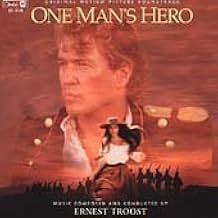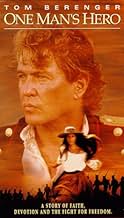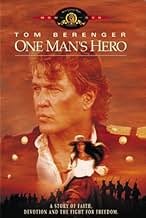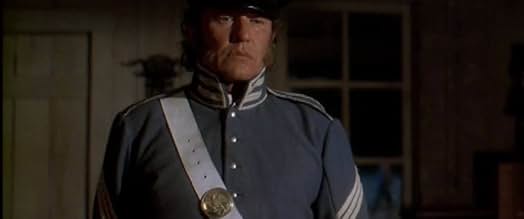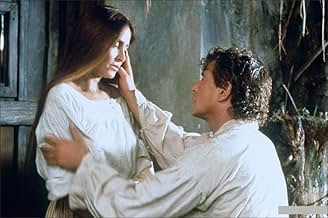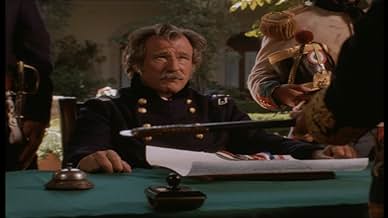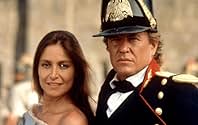VALUTAZIONE IMDb
6,0/10
1413
LA TUA VALUTAZIONE
Aggiungi una trama nella tua linguaJohn Riley, an Irish immigrant soldier recruited in the American army during the Mexican-American War faces anti-immigrant and anti-Catholic bigotry from his fellow servicemen and defects to... Leggi tuttoJohn Riley, an Irish immigrant soldier recruited in the American army during the Mexican-American War faces anti-immigrant and anti-Catholic bigotry from his fellow servicemen and defects to the Mexican army.John Riley, an Irish immigrant soldier recruited in the American army during the Mexican-American War faces anti-immigrant and anti-Catholic bigotry from his fellow servicemen and defects to the Mexican army.
- Regia
- Sceneggiatura
- Star
- Premi
- 3 candidature totali
Recensioni in evidenza
Anyone who doubts the power of religion to sway a man's loyalties has never studied history. Likewise, anyone who doubts the power of a man's need to feel respect and a sense of "belonging" has simply never felt the lack. The Irish of the time came to our shores fleeing famine and disease, poor in the wallet but rich in pride and heritage. They asked for nothing but a chance, and took what was offered in good faith. The politics of the time made them much as the Mexicans are viewed today. Unwanted aliens who should be sent back from whence they came. Taking the offer of the US Army at face value, they were ridiculed and scorned and abused constantly. When battle was joined they found themselves fighting a people not so different from themselves. A people who shared ties of Catholicism, as well as spirit. They got nothing but hatred and ridicule from those who supposedly would welcome them, and could not be proud of fighting Mexicans, who shared so much in common with them. All they asked was a place to belong. Once they found it, they fought for it with all they had. It just happened, they found it in the ones they were supposed to be fighting.
When it comes films based on true events, it is in the filmmakers' best interest to keep all the facts as legitimate as possible without skewing the story all that much. The genre of films that probably receives the most critical of film buffs' attentions are the ones that have been historically recorded and not some fable spread by rumors and myths. Taking a deeper look, the type of historical film that gets this kind of focus is usually bio-pictures or war dramas. Further closing the gap, the war dramas that have received the motion picture treatment range; but several have depicted these tragedies during the Great War, World War II, the Vietnam War, the Revolutionary War and the American Civil War. Of course in world history, these are not the only confrontations that occurred, but for North American history, this is the usual batch. It is rare when another event is looked at that possibly was forgotten in the regular high school history books. The most recent that comes to mind is Heaven's Gate (1980), which was about a county war in 1890.
Turns out this movie takes place during the 19th century as well. Lance Hool, a producer to other various films like Missing in Action (1984), The Air Up There (1994), Flipper (1996) and Man on Fire (2004), takes a turn in the director's chair to cover the Mexican-American War in 1846. Written by Milton S. Gelman (who passed practically a decade before this film's release), the story is about real-life soldier Sergeant John Riley (Tom Berenger) and his men who abandoned the U.S. army after being persecuted because of their Catholic faith. While leaving, they find refuge with fellow Mexicans led by Cortina (Joaquim de Almeida) and Marta (Daniela Romo). There, they both decide to join Mexico and fight for their freedom. Meanwhile, Colonel Benton Lacy (Mark Moses) attempts to get Riley back to the north before General Winfield Scott (Patrick Bergin) blows them all away. Running parallel to that, Marta and Riley start to become more attracted to each other every minute they spend together.
For problems, there isn't all too much to gripe about. The only script issues that are obvious deal with character motivations. From what is known, John Riley is somewhat a mystery but only after the Mexican- American war ended. There are documents of his existence but there isn't a clear answer as to what he did post-war. Did he marry for real? In this feature, Marta is Riley's love interest as is she to Cortina. The passion that Riley has for Marta is a constant subplot that is brought up every half-hour or so. Yet Cortina repetitively reminds Riley to stay away, but Riley doesn't listen. Soon, Riley and Cortina fight and immediately right after; it's water under the bridge for some odd reason. What was all the antagonizing for if it was going to be settled so quickly? Was it even worth writing in? The only other dilemma in this movie is more technical and that's the depiction of war. This film was Orion Pictures last release and many of the studio's films were rated R (as was this one). Still there seems to be almost no blood or gore.
That particular aspect was probably the most inaccurate component. War is not light and fluffy stuff. There are a couple scenes where blood does flow but it's rated R. Gettysburg (1993) also should have been R but it was PG so the depiction of violence was much less gruesome and that's only appropriate because of its rating. Why give a movie the label of rated R if won't even play out as an R rated film? It's misleading. The cast to the film was also entertaining. Hearing Tom Berenger with an Irish accent is definitely a change in his usual speech pattern and it does sound authentic, as well as the soldiers played by Stuart Graham, Gregg Fitzgerald, Don Wycherley, Wolf Muser and Luke Hayden. Each actor equally matches Berenger in amiability. Daniela Romo as Marta is very pretty and it is obvious as to why Riley falls for her so quickly. Joaquim de Almeida is always fun to watch but in his role as Cortina, it's hard to know how trustworthy he is. Mark Moses performance as Colonel Lacy is another great show. Moses knows how to have a presence.
Visually, the film had an appealing look to it. All effects looked like they were executed practically, of which regularly gives a movie a more realistic viewing. Credit to João Fernandes as the director of photography for capturing wide shots of the western North American terrain. The actual depiction may not feel it has the right temperature to walk in casual clothing but it rightfully matches the environment of what the west was like. Fernandes was also the cinematographer for Friday the 13th Part IV: The Final Chapter (1984), Missing in Action (1984) and Red Scorpion (1988). The film score produced by Ernest Troost was another great element. Troost also composed the music to both horror comedies Tremors (1990) and Dead Heat (1988). Unlike Dead Heat (1988) though where the orchestra sounded like it came from an oldies monster film, Troost's orchestra to this film is much more full and contemporary. The main title is very applicable to the setting, with bagpipes representing Riley and his men. There's also a choir to boot.
It has some weird character motivations and underwhelming violence for an R rated war film, however it is an immersive film. The story provides a new history lesson to those unfamiliar of the Mexican-American war, the actors perform great, and the cinematography is befitting to the setting as well as the film score.
Turns out this movie takes place during the 19th century as well. Lance Hool, a producer to other various films like Missing in Action (1984), The Air Up There (1994), Flipper (1996) and Man on Fire (2004), takes a turn in the director's chair to cover the Mexican-American War in 1846. Written by Milton S. Gelman (who passed practically a decade before this film's release), the story is about real-life soldier Sergeant John Riley (Tom Berenger) and his men who abandoned the U.S. army after being persecuted because of their Catholic faith. While leaving, they find refuge with fellow Mexicans led by Cortina (Joaquim de Almeida) and Marta (Daniela Romo). There, they both decide to join Mexico and fight for their freedom. Meanwhile, Colonel Benton Lacy (Mark Moses) attempts to get Riley back to the north before General Winfield Scott (Patrick Bergin) blows them all away. Running parallel to that, Marta and Riley start to become more attracted to each other every minute they spend together.
For problems, there isn't all too much to gripe about. The only script issues that are obvious deal with character motivations. From what is known, John Riley is somewhat a mystery but only after the Mexican- American war ended. There are documents of his existence but there isn't a clear answer as to what he did post-war. Did he marry for real? In this feature, Marta is Riley's love interest as is she to Cortina. The passion that Riley has for Marta is a constant subplot that is brought up every half-hour or so. Yet Cortina repetitively reminds Riley to stay away, but Riley doesn't listen. Soon, Riley and Cortina fight and immediately right after; it's water under the bridge for some odd reason. What was all the antagonizing for if it was going to be settled so quickly? Was it even worth writing in? The only other dilemma in this movie is more technical and that's the depiction of war. This film was Orion Pictures last release and many of the studio's films were rated R (as was this one). Still there seems to be almost no blood or gore.
That particular aspect was probably the most inaccurate component. War is not light and fluffy stuff. There are a couple scenes where blood does flow but it's rated R. Gettysburg (1993) also should have been R but it was PG so the depiction of violence was much less gruesome and that's only appropriate because of its rating. Why give a movie the label of rated R if won't even play out as an R rated film? It's misleading. The cast to the film was also entertaining. Hearing Tom Berenger with an Irish accent is definitely a change in his usual speech pattern and it does sound authentic, as well as the soldiers played by Stuart Graham, Gregg Fitzgerald, Don Wycherley, Wolf Muser and Luke Hayden. Each actor equally matches Berenger in amiability. Daniela Romo as Marta is very pretty and it is obvious as to why Riley falls for her so quickly. Joaquim de Almeida is always fun to watch but in his role as Cortina, it's hard to know how trustworthy he is. Mark Moses performance as Colonel Lacy is another great show. Moses knows how to have a presence.
Visually, the film had an appealing look to it. All effects looked like they were executed practically, of which regularly gives a movie a more realistic viewing. Credit to João Fernandes as the director of photography for capturing wide shots of the western North American terrain. The actual depiction may not feel it has the right temperature to walk in casual clothing but it rightfully matches the environment of what the west was like. Fernandes was also the cinematographer for Friday the 13th Part IV: The Final Chapter (1984), Missing in Action (1984) and Red Scorpion (1988). The film score produced by Ernest Troost was another great element. Troost also composed the music to both horror comedies Tremors (1990) and Dead Heat (1988). Unlike Dead Heat (1988) though where the orchestra sounded like it came from an oldies monster film, Troost's orchestra to this film is much more full and contemporary. The main title is very applicable to the setting, with bagpipes representing Riley and his men. There's also a choir to boot.
It has some weird character motivations and underwhelming violence for an R rated war film, however it is an immersive film. The story provides a new history lesson to those unfamiliar of the Mexican-American war, the actors perform great, and the cinematography is befitting to the setting as well as the film score.
John Riley did indeed lead Irish deserters for Mexico in the war. The Irish were ill-used by Nativist officers who didn't like 'croppies.' Protestant America was feeling threatened by the huge influx of Catholic Irish flooding into the US from famine-struck Ireland. Few troops have been given more reason to desert. However, the movie tells it all wrong. Riley wasn't a sergeant and didn't plan to return after getting his men to safety. He was a private who swam the Rio Grande a month before the war was declared. He responded to 'desertion leaflets' that the Mexicans had sneaked into American Camps. No US army ever had higher desertion rates.
The treatment of Winfield Scott is rather harsh. Riley was actually sentenced to hang with virtually all of his men but it was Scott who commuted his sentence (the still harsh 50 lashes and branding), along with that of more than a score of his men. This infuriated Scott's Nativist officers.
Riley remained in the Mexican Army after the war for a year or so and almost certainly returned to Ireland thereafter. Also, he was a young fellow, about thirty, which made it hard to accept Tom in the role. Another thing that was irritating is that there is a list of the men who served under Riley and it is amazing that the screenwriter decided to create fictional replacements instead. Why? Also, one must not forget that most Irish, despite poor treatment by prejudiced officers, did not desert. Who was more heroic, those who deserted or those who didn't?
All in all, a disappointment. However, it is one of the very few films that deals with the Mexican American War, and for that I commend it.
The treatment of Winfield Scott is rather harsh. Riley was actually sentenced to hang with virtually all of his men but it was Scott who commuted his sentence (the still harsh 50 lashes and branding), along with that of more than a score of his men. This infuriated Scott's Nativist officers.
Riley remained in the Mexican Army after the war for a year or so and almost certainly returned to Ireland thereafter. Also, he was a young fellow, about thirty, which made it hard to accept Tom in the role. Another thing that was irritating is that there is a list of the men who served under Riley and it is amazing that the screenwriter decided to create fictional replacements instead. Why? Also, one must not forget that most Irish, despite poor treatment by prejudiced officers, did not desert. Who was more heroic, those who deserted or those who didn't?
All in all, a disappointment. However, it is one of the very few films that deals with the Mexican American War, and for that I commend it.
An epic, slow grinding war story of source accounts with romance, faith and loyalty streaming through. I don't know how true it is to the facts, but you couldn't help but admire its powerful scope and sound performances led by Tom Berenger. Irishman John Riley leads his fellow countrymen who desert to Mexico just before the American-Mexican war after encountering religious and ethnic prejudice in the US cavalry. While holding up in Mexico, war is ignited and the men form the St Patrick's brigade where they become allies with the Mexicans. The story shows how much in common these two sides shared in their viewpoint of freedom, which the Irish men saw when they lived and fought side by side with the Mexicans. They kept fighting on, despite the odds being stacked up against them. The war scenes are dramatically staged with strategic precision and bravery, as it becomes a stirring display of chemistry and spirit between the cast. The characters do provide good insight and form lasting impressions, making the entire ordeal even more effective when they meet their fate. Joaquim de Almeida is perfectly strong willed as a Mexican outlaw and Daniela Roma as the Mexican lady caught in a love triangle.
"One man's hero. Is another man's traitor I reckon sir."
"One man's hero. Is another man's traitor I reckon sir."
10theeht
Someday, perhaps, when this film achieves the reputation as a classic that it deserves it will be widely re-released. A labor of love for Berenger, it features the acclaimed actor in possibly his greatest performance as an Irish sergeant who fights with his men on the side of the Mexicans during the Mexican war. Tom is incredible here, especially in the closing scenes, but everything is superb here, the music, photography, direction by Lance Hool, supporting performances, everything you could ask for in a spectacle like this.See this film.
Lo sapevi?
- QuizThis was the last film ever released by Orion Pictures.
- BlooperThere are a number of geographical and historical errors in this film, including some scenes in the battle of Churubusco (the last battle in the movie).
I più visti
Accedi per valutare e creare un elenco di titoli salvati per ottenere consigli personalizzati
- How long is One Man's Hero?Powered by Alexa
Dettagli
Botteghino
- Budget
- 11.350.000 USD (previsto)
- Lordo Stati Uniti e Canada
- 240.067 USD
- Fine settimana di apertura Stati Uniti e Canada
- 108.567 USD
- 26 set 1999
- Lordo in tutto il mondo
- 240.067 USD
- Tempo di esecuzione2 ore 1 minuto
- Colore
- Mix di suoni
- Proporzioni
- 2.35 : 1
Contribuisci a questa pagina
Suggerisci una modifica o aggiungi i contenuti mancanti

